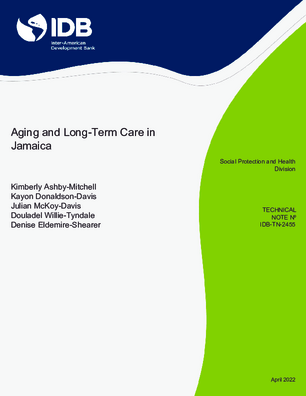Aging and Long-Term Care in Jamaica
Date issued
Apr 2022
Subject
Health;
Population Aging;
Women;
Gender;
Ministries;
Healthcare Access
JEL code
I18 - Government Policy • Regulation • Public Health;
J18 - Public Policy;
H50 - National Government Expenditures and Related Policies: General
Country
Jamaica
Category
Technical Notes;
Co-Publications
Recent estimates show that almost 15% of the Jamaican population is 60 years old or more. About 7% of this population need help with at least one activity of daily living. The demand for long-term care services is expected to rise as the countrys population grows older. In a context in which family sizes are shrinking and older adults are experiencing poor health and critical socioeconomic vulnerability, the means to meet care needs privatelyeither by relying on unpaid care, provided by their families or close networks, or by purchasing services in the marketare scarce.
The regulation and provision of long-term care services in the country is highly fragmented and focuses mostly on those that are economically and socially vulnerable, as part of poverty-relief programs.
Residential care is the main long-term care service available in Jamaica. Public institutions target the poor, while the private sector also offers various levels of institutional care, from residential to nursing care. The nongovernmental sector is also heavily involved in the provision of residential care in Jamaica, especially through churches. All things considered, women in the family are still the main providers of care. The main conclusion of the report is that long-term care in Jamaica is still an unmet need that requires the development of comprehensive policies and programs.
The regulation and provision of long-term care services in the country is highly fragmented and focuses mostly on those that are economically and socially vulnerable, as part of poverty-relief programs.
Residential care is the main long-term care service available in Jamaica. Public institutions target the poor, while the private sector also offers various levels of institutional care, from residential to nursing care. The nongovernmental sector is also heavily involved in the provision of residential care in Jamaica, especially through churches. All things considered, women in the family are still the main providers of care. The main conclusion of the report is that long-term care in Jamaica is still an unmet need that requires the development of comprehensive policies and programs.



